


For those of you who would still like a downloadable, off line version of the Newsletter, Click Here
Hawker Fury Replica takes to the skies
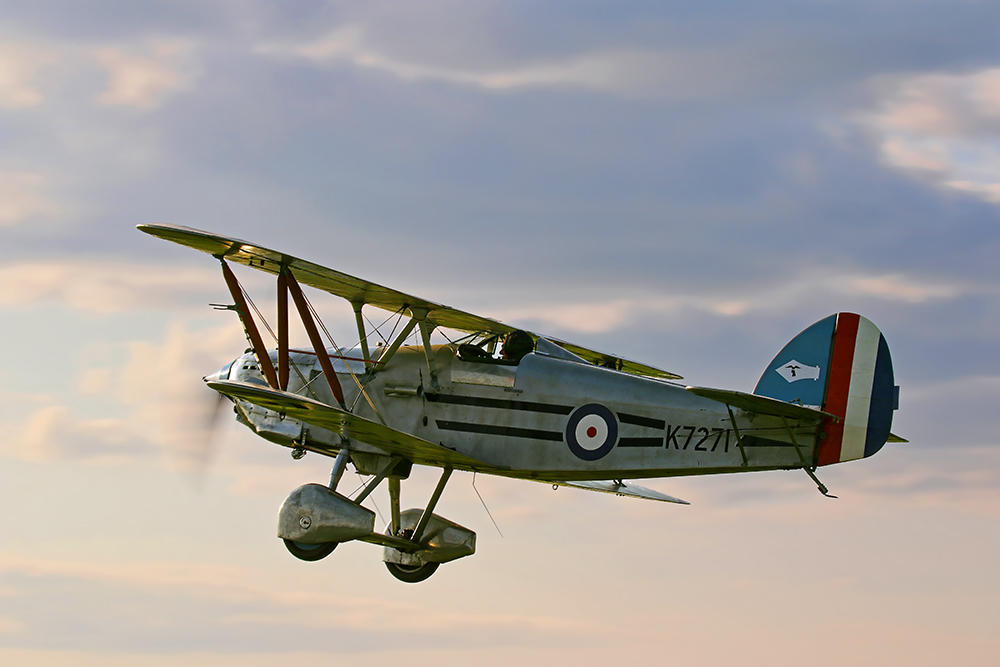
The winter cold snaps have arrived as I am sure you have noticed, dialling up the central heating, trying not to think about the energy bill, or reaching for an extra sweater. Shorter days don’t add to the enjoyment of life either. We batten down the hatches as far as flying is concerned generally speaking, though the odd fine winters days flying can be a bonus. I can however, recommend jetting off to a sunnier climate, in my case 10 days in Greece, or Corfu to be precise, it all came about when I listed a bunch of aircraft instruments on AFORS which generated an enquiry from Kosta.
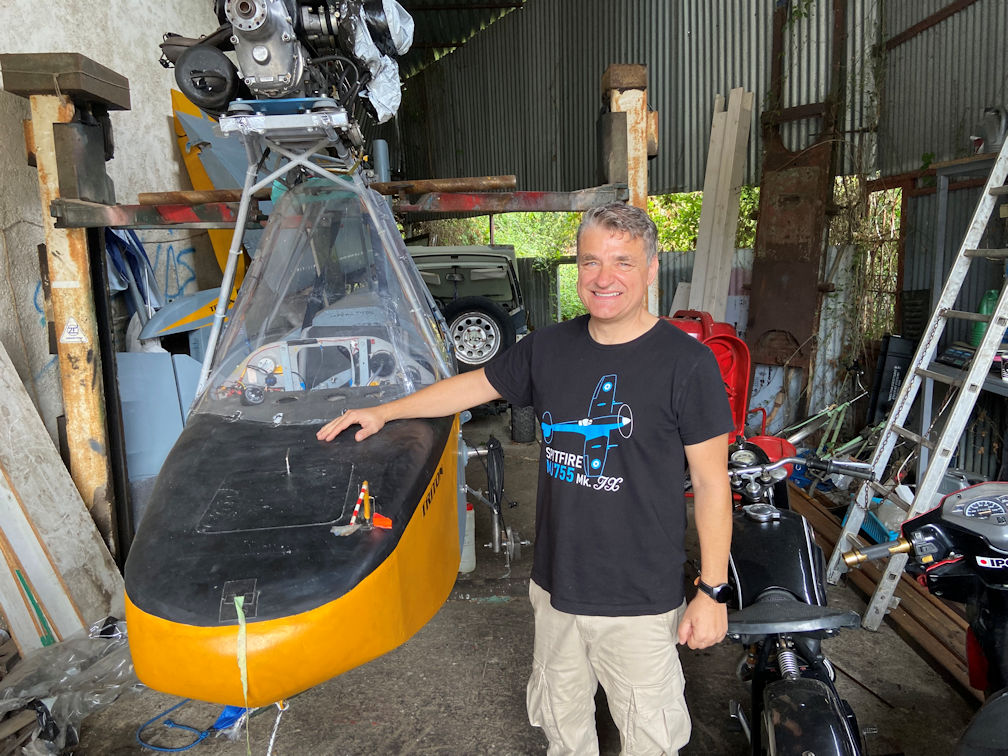
He was building an amphibian of his own design and needed to fill up the panel with the basic instruments. Kosta is a very talented guy with engineering and design knowledge and he has produced a beautiful example of a true homebuilders aircraft. It goes to show that when we have our LAA or AFORS to communicate, we can help one another out when sourcing all the bits and pieces needed to complete our projects. I am not a big fan of ordering everything out of the mail order catalogues, convenient, but very expensive !!!. Spending out £30,000 to build a £15,000 valued aeroplane is not my idea of having fun, we start the treasure hunt instead, which is all part of the fun, plus, you meet a lot of likeminded people along the way. All credit to the builders of “hot ships” though, glass cockpits. VP props and all the bells and whistles, well done too.
Next year brings us to the 80th anniversary of PFA / LAA and we want to celebrate in some style. A summer fly In / BBQ or a special something to mark the event, if you have any suggestions, let’s hear about them, always happy to get your ideas !
Next month : Our December 9th speaker is Richard Chatham, a local aviation historian with a well documented history of aviation activities during World War Two at Stoke Orchard airfield, a lot of information I had no idea about, it will be a good one, try not to miss this one. In addition we have our traditional Christmas mince pies and wine to get us in the mood for the BIG bash to come. Bring some small change to throw into the pot.
Last month Alexander Norman presented his new book to us – “Captain De Havilland’s Moth “, Tales of High Adventure from the Golden Age of Aviation, a heady mixture of record breaking flights, great determination and sheer guts combining together to provide a very glamourous time in aviation, they don’t make them like that any more !!.
CONTACT / CHOCKS AWAY !!
Mike
The last meeting
Long term Strut member, well-known aviation enthusiast and ace photographer, Steve Smith, took us on a trip with him to the Hahnweide air rally which he and fellow Strut member Tim Badham had visited this September. And who should they find there but that inveterate air show visitor, Nigel Hitchman who we see so often at our summer meetings that he’s almost another Strut member! Tim was there in his capacity as Editor and chief reporter of The Vintager and Classic Aircraft Magazine.

Hahnweide, a substantial grass airfield, is the home of a German gliding club but its rallies, held in the September roughly every other year, give or take the odd Covid outbreak, have become a major event in the European aviation calendar, attracting hundreds of aircraft over a 3-day weekend. At least one Brit arrived in his own aircraft – Tony Ryan-Fecitt in his lovely blue Air Camper which you may remember he brought to Croft Farm earlier this year. Steve and Tim had flown down on a commercial flight – it’s probably possible to fly from Birmingham, Bristol or Heathrow. It would be at least a 2-day drive - It’s just a few miles south of Stuttgart so you could collect your new Mercedes while you’re at it.
The show attracts 35-40,000 members of the public and 3-400 aircraft.
In addition to the resident gliders, the rally attracts private aircraft from all over Europe, including many warbirds and old-timers, including interesting replicas, the oldest of which was a replica Bleriot. There were several other rare examples, such as an original Me 108, a Daimler-Benz engined Me-109, an FW 190 and three Junkers F-13 replicas.
As if the arrivals and departures were not interesting enough, there were several air displays over the weekend, including a spectacular glider formation show. Steve was keen for us to know that a visit is well worth the effort of travelling so far.
Many thanks, Steve for a most entertaining evening.
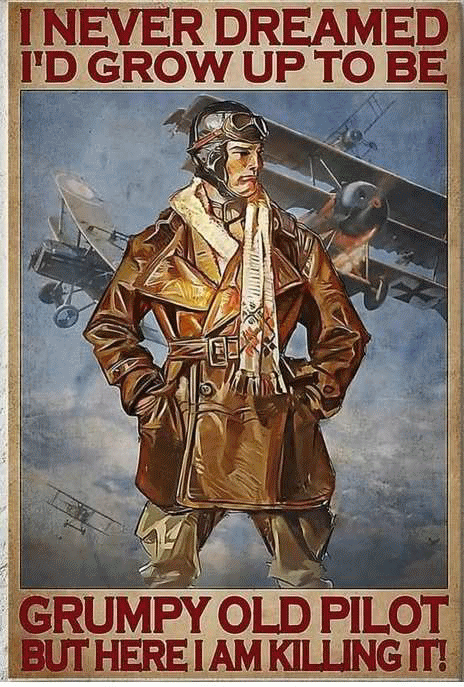
Qantas Engineering Reports
Alleged reports filed by Qantas Airline Pilots and the Engineering Responses - A short series.
Pilot: Target radar hums
Engineer: Reprogrammed target radar with lyrics
The only mystery in life is why the kamikaze pilots wore helmets.
Part Two of David Joyces' flight safety article
In my second example imagine your engine fails after take off at 800ft. Ahead are the suburbs of some city with no clear landing areas. What do you do? Is 800 ft enough to turn around from? Your instructor said always land ahead within a narrow angle, but you can’t remember any height stipulation and you never practiced an EFATO at 800 ft and certainly not in such an unpromising situation as this.

After some time frantically mulling over the options (and losing speed and height) you decide that landing ahead will probably kill you and therefore you will turn around.
If you are lucky you haven’t let your speed decay already to the point where the plane is just waiting for the merest twitch of the rudder or even the increased 'g' of a gentle, coordinated turn before falling out of the sky. How best to turn? Nearly everyone I have asked says ‘fly at best glide speed at a bank angle of either 30 or possibly 20 degrees’. If this is what you do you will not get back to the airfield. Extensive expert mathematical studies have shown that the most efficient way of turning with minimal height loss is at 45 degrees bank with speed as near to stall as you can manage.
The diameter of turns for any plane at typical Europa speeds and banks:
| Speed | Bank Angle: | 20 deg | 30 deg | 45 deg |
|---|---|---|---|---|
| 50 kts | 1260 ft | 790 ft | 445 ft | |
| 60 kts | 1800 ft | 1120 ft | 640 ft | |
| 70 kts | 2450 ft | 1530 ft | 870 ft |
The 45 degree/50kts example needs a health warning. Most Europas would not be able to manage this without stalling as the stall speed is increased by some 19% at 45 degrees and the Handbook stall speed of 44 kts becomes something like 52 kts. My own aircraft stalls at 38- 40kts and I find I can maintain the 45/50 combination of bank and speed.
There is a nearly four fold difference between the 50kts/45 degrees figure and the commonly assumed optimum of 70kts/30degrees, let alone 70/20. The 70/30 turn takes you over a quarter mile from the centreline and the 70/20 option nearer half a mile. With the 50/45 choice there is a likelihood that you will drift much or all of the 445 ft back to the centreline, always assuming that you were awake enough to turn into any crosswind. It is tempting to calculate height loss from these dimensions on the assumption of a 1-12 glide angle, but it doesn’t work that way. As soon as one turns the glide angle deteriorates and the only way of knowing how much height you would lose in completing a turn is to go and measure it in your plane. It is easy to measure height loss whilst completing a 360 degree turn. This is very close or identical to the height loss in the sort of ‘P’ turn needed to get back to your original runway centreline, in the absence of favourable side wind drift. For my monowheel Europa (which is aerodynamically more efficient than most small planes) the measured figures are shown below.
| Speed/Angle of Bank | 70 kts/30 deg | 50 kts/45 deg |
|---|---|---|
| Height Loss | 1070 ft | 440 ft |
Measured height loss to complete a 360 degree turn with engine idling (in a Europa XS Mono)
So on the face of it I could hope to get back to the airfield reasonably comfortably from 800 ft at 50kts and 45 degrees, but if you followed your instincts and tried the faster, less banked option, you would have no hope at all, and might find yourself doing the fatal thing of easing up the nose in the hope of going a bit further. These figures are incidentally also highly relevant if you find yourself forced to turn in a valley. Some of my more sporting friends have suggested they might do a stall turn or a wingover to turn around after an EFATO or in a valley, but such aerobatic manoeuvres need appreciable starting speeds, typically over 100kts. If as is likely your speed is already low, forget it. Simply to speed up from 70 to 100kts needs a dive of 230 ft, without taking air resistance/drag into account, so probably at least 300ft and likely to need more nerve and presence of mind than most will have available in such a crunch situation!
This of course glosses over the question of whether you can hope to safely do a slow, well banked turn with the engine out, and I certainly wouldn’t suggest that you wait for your next EFATO to find out.
It would be madness to contemplate this without having practiced it repeatedly!
You clearly need to experiment at a safe height and work out what does it for you. My Europa stalls at about 38kts level and at about 45 kts at 45 degrees, but I find it surprisingly comfortable turning at 50kts/45deg (with flaps down). So I know now that if my engine fails at 500ft or more and the view out the front looks awful, I can turn with every prospect of safely heading back towards the airfield. Whether you have the range to reach the airfield is another matter depending on its length and your climb rate before the engine failure. There is also the possibility of course of there being a perfect golf course or playing field off at say 90 degrees. The key thing is that you know how to turn efficiently and have practiced doing it. Incidentally the figures above were achieved with the engine idling, which is widely accepted as adding more drag than a stopped propeller. For my 914 engine with Woodcomp high twist W blades, the prop still windmills at 50 kts ignition off, so it is academic for me, but for those whose engine will stop rotating a stopped engine should be more favourable than an engine idling practice scenario. The process of doing the slow 45 degree banked turn is so unusual and involves having the stick further back than normal, and I find it really grabs your attention, and as you are effectively no longer frantically looking for a landing site it seems much less likely to lead to unintentional speed decay.
Should the engine go quiet at a lower height or should there be reasonable landing options ahead, what speed do you adopt? Again many I have spoken to have said best glide speed, but you are in effect on short final, so I would suggest that adopting your normal approach speed or even a short field approach speed with the gear down is what you should aim for immediately after correcting your nose up attitude. Hitting a tree or a wall at 50kts is a whole lot less damaging than at 70kts.
The energy of impact is virtually double at 70kts compared with 50kts, (98% greater to be precise)
One final bit of emergency performance to mention is side slipping.
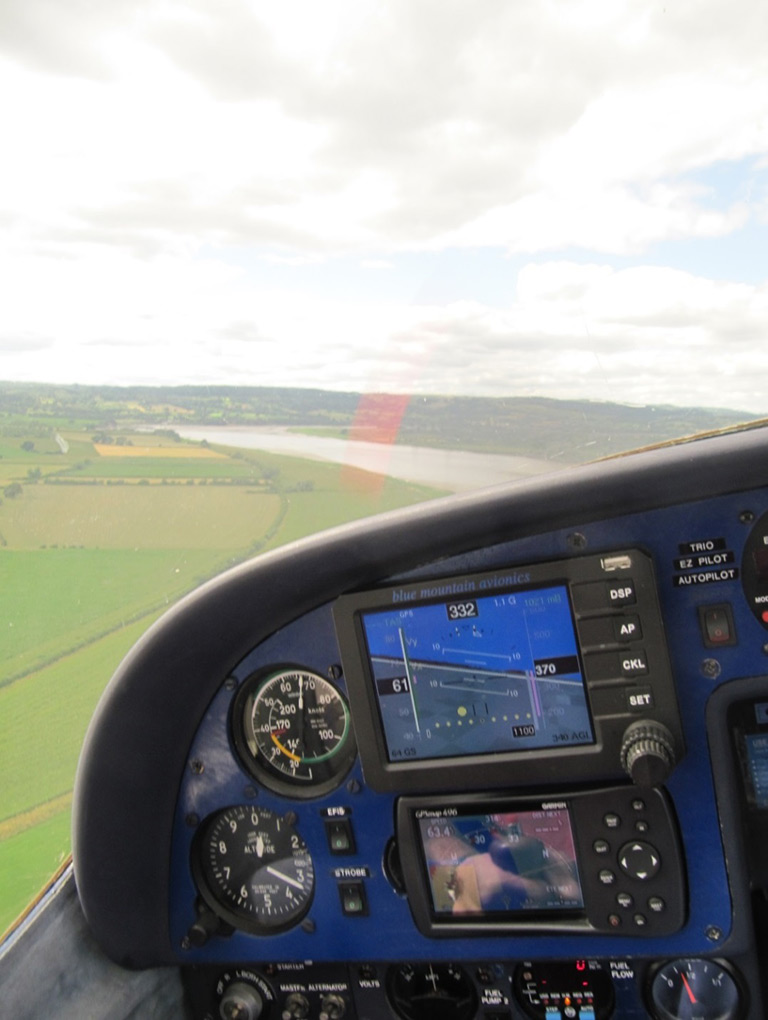
Sadly it is not taught in the PPL syllabus and I get the impression that relatively few GA pilots ever get on top of it. The Europa along with the large majority of Permit aircraft are capable of safe, effective side slipping. I suggest to you that it is an important tool in any emergency landing. How often with a power on landing do you find yourself suddenly sinking faster as you approach the fence, and have to put in a good dollop of power to touch down where you originally intended? The same risk of course is there for power off approaches (wind shear or some other aspect of Sod’s Law!). You may possibly have the luxury of being able to aim a third of the way along an 800 yard field, but it is much more likely that you will be sweating to get it into barely 300yds, knowing that you have to aim short if you are not going to end up a real mess in the far hedge or wall. If you are comfortable side slipping, you can routinely go in a bit high and burn off any extra by side slipping once you are confident of not undershooting. Alternatively if it becomes apparent that you cannot make your chosen field it is a useful, potentially life saving tool in getting it down in some sort of shape in the previous field, rather than hitting the hedge/ditch/wall at full flying speed.
Meaningful Practice
I suspect there are few of us who don’t sometimes just go flying for the pleasure of getting off the ground, and we just wander round the locality admiring the view before landing. I suggest that these sorts of flights shouldn’t just serve to boost that feel good factor but should be used regularly to practice key skills. In addition, if you don’t already know the answers, you should take the opportunity to explore your plane’s performance in emergency simulations. Do accurate measurements in still air of your descent rate (time how long it takes to descend 1,000 ft) at different speeds with engine idling (or off if you have the welly!) so as to be able to compute glide angle. And I strongly recommend practicing minimal height loss turns by doing 360 degree turns at a safe height and over some readily seen linear feature, measuring height loss at various speeds and bank angles. This will let you know what is the most efficient way to turn your plane, in case you find you have to. If you are not confident side slipping then practice it at a safe height. Then that surge of ‘Feelgoodness’ that we all get from being in the air can be augmented by a bit of ‘Feelsmartness’ knowing that you have sharpened your survival skills!
To summarise – Being absolutely clear how your plane performs in emergencies significantly reduces the risk of you making the wrong decision or suffering from indecision long enough to seriously aggravate the situation. Installing helpful electronics provides you with a powerful means of preventing lethal speed decay and on its own probably removes 75% of your risk. Practicing key manoeuvres and skills regularly makes it much more likely that you will make the right decision and carry it out successfully, thus removing most of what risk remains. You may have correctly got the impression that I am a bit evangelical about stall/spin accidents. This largely came about from having been uncomfortably close to the appalling Europa accident at Kemble (my then home airfield) a few years back, where a father and daughter spun in after take off from around 500ft. The details, as the BBC is wont to say, are too unpleasant to recount here.
Happy Landings, David Joyce
Next month we will hear Davids views on ditching.
Dates for your diary
As you might imagine, not much happening at this time of year
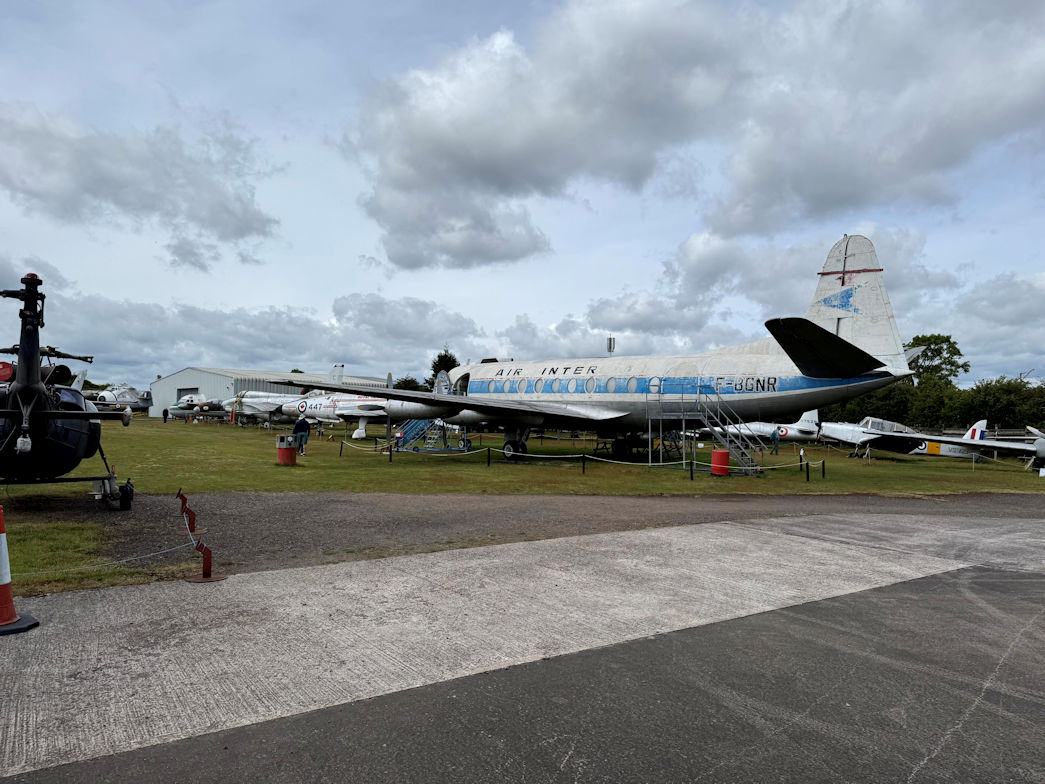
06/12/2025
Compton Abbas Christmas Fly In
Looking ahead...
21-22/02/2026
Old Warden Shuttleworth workshop Open Days
02-03/05/2026
Popham Microlight Trade Fair
10/05/2026
Old Warden Season Premiere
Another one quite a way ahead...
Date: 4/5/6 September 2026
We’re thrilled to announce that our 2026 Rally is officially in the calendar! Mark your diaries and get ready for a special rally, celebrating the LAA 80th Anniversary.
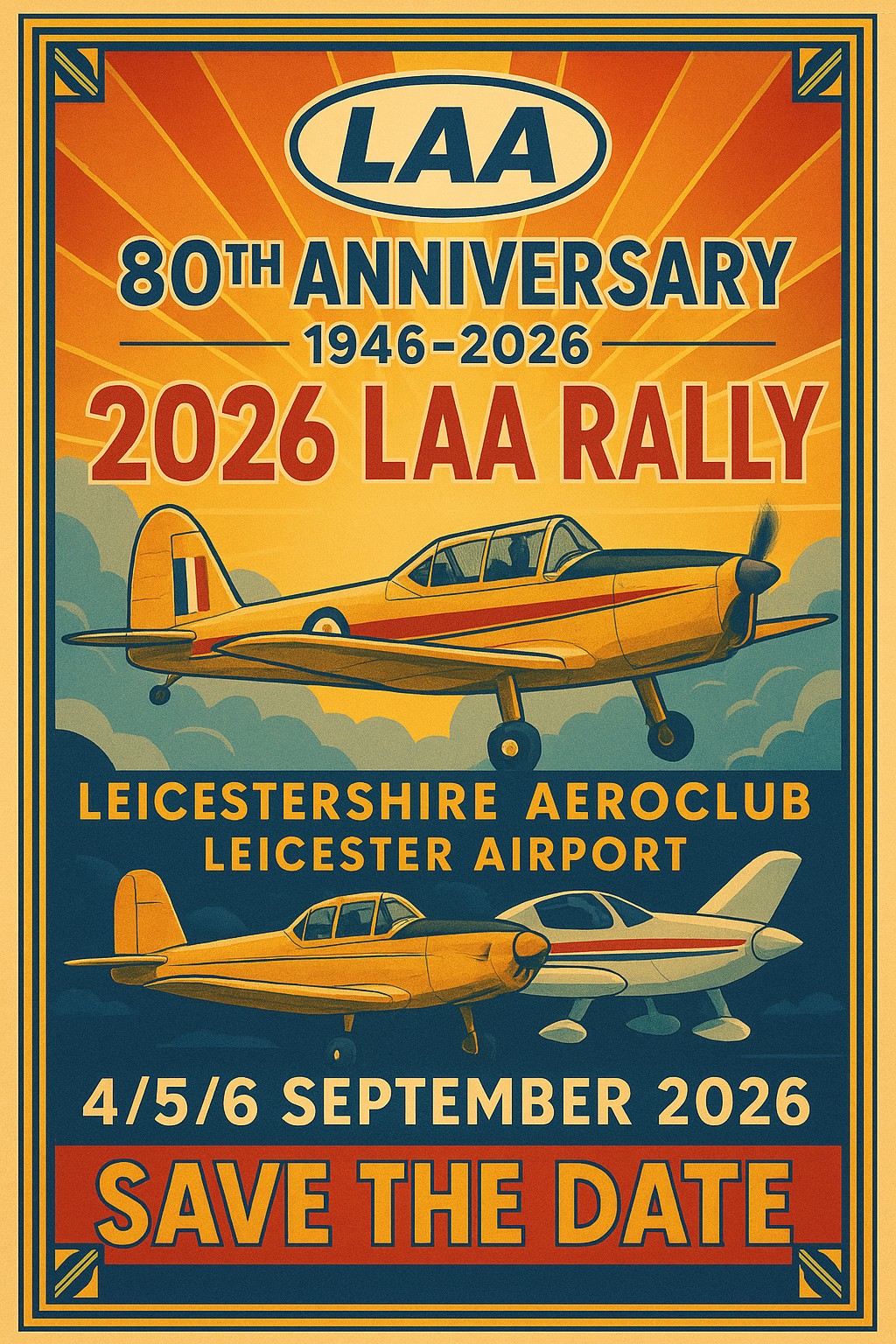
Location: Leicestershire Aero-club: Leicester Airport.
More details will follow soon.
Enquiries to nancy.lillington@laa.uk.com
We can’t wait to see you all there!
Warm regards,
Simon and the rally team.
The October edition of AIRPROX INSIGHT features an Airprox between a Wildcat helicopter and a glider at Nympsfield glider site. The article discusses the importance of adequate pre-flight preparation, including the use of appropriate tools and methods for ensuring that account is taken of all potential hazards along or near to the planned route. It also talks about considerations regarding selection of enroute transit altitudes, and how choosing the right level to fly at can keep us away from potential hazards such as visual circuits at minor aerodromes and glider sites.
CHIRP General Aviation FEEDBACK Edition 106
The November 2025 edition of CHIRP General Aviation FEEDBACK, Small Slips, Big Lessons, examines how minor lapses or assumptions can have outsized consequences. Reports cover a microlight entering controlled airspace, a parachutist handling a serious malfunction, a pilot bumping a wingtip on the ground and a Chipmunk pilot inadvertently switching off a magneto in flight. Alongside human factors insights, pre-flight awareness tips, and lessons on technology reliance, this edition highlights the benefits of reflection and learning from experience. Whatever your story, please share it confidentially with CHIRP.
CHIRP Air Transport FEEDBACK Edition 156
Have you ever wondered what role safety reporting plays in flight safety? Or pondered on what the barriers to reporting can be? In CHIRP Air Transport FEEDBACK Edition 156 the theme of reporting touches on a wide range of issues from the reports CHIRP selected to feature in this edition, varying from a safety of flight issue with an iPad flight deck trial installation to the expected use of Captains Discretion to complete duties.
This edition also features a discussion based on a social media post by Chesley “Sully” Sullenberger – why don’t you write in to CHIRP with your thoughts on what is said?
CAP 740 issue 10
Issue 10 of CAP 740 is a complete re-issue. The document has been updated to incorporate strategic objectives within the Flexible Use of Airspace Strategy; include the accountabilities of the civil and military airspace managers, and to ensure the interests of all airspace users, including new entrants and commercial entities, are dealt with impartially in accordance with the UK’s joint and integrated concept.
UK Flight Crew Licensing Regulations – Webinar Recordings
Following recent changes to UK Flight Crew Licensing Regulations, the CAAs General Aviation Unit hosted a series of webinars to explain the updates.
Recordings of the webinars covering changes for aeroplanes and microlights, helicopters and gyroplanes, and sailplanes are now available to view on our website.
If you have any further questions, contact us at ga@caa.co.uk.
Flying Display Season 2025 – Post-Season Report Published
The CAA has published its post-season report for the 2025 Flying Display Season, which highlights improved service delivery, increased application volumes, and key safety insights.
Airspace Safety: Gatwick and Redhill
The Airspace & Safety Initiative has published an updated infringement hot-spot narrative focusing on Gatwick Controlled Airspace and Redhill Aerodrome.
Written by the Gatwick Local Airspace Infringement Team, it explains the effect of infringements on Terminal Control and Gatwick Approach, and provides practical advice with links to further information.
This and other hot-spot and occurrence narratives highlight issues and guidance that could apply wherever you plan to fly.
Coventry Airport
The future of this airport is uncertain but looking like it will close to be replaced by an electric car battery manufacturing site. A great shame as it is quite a nice airport with an extremely helpful and friendly ATC, plus the proximity of the museum (10 minutes walk) makes it a nice day out.Popham Airfield
Was under threat, then had a reprieve due to the large number of objectors to its closure, now under threat again as the local council have decided to ignore the protests and carry on regardless.Redhill Airfield
Tandridge District Council which includes Redhill are looking at sites for housing development. Airfields seem like an easy target and Redhill is in their sights. Take a look here for more information.Whether or not you need to fill in a GAR (General Aviation Report) for a particular flight? Well, worry no more! This useful tool will give you the answer you want, written by Northern Irelands C42 pilot, Barry Flood. Of course, it doesn't actually fill in the GAR for you but at least it sets your mind at rest as to whether it is required or not.
The December Strut meeting will be held on Tuesday 9th December at the Victory Club in Cheltenham. There will be wine and mince pies! The speaker will be Richard Chatham, a local aviation historian presenting the history of aviation activities during World War Two at Stoke Orchard airfield. Not to be missed.
Perhaps a little early but here goes...
Merry Christmas to all our members and readers. Let's hope 2026 is a great year for flying. Stay safe!
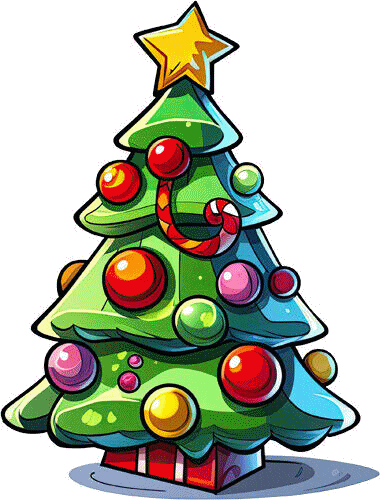
| January 2025 | February 2025 | March 2025 |
| April 2025 | May 2025 | June 2025 |
| July 2025 | August 2025 | September 2025 |
| October 2025 | November 2025 |










